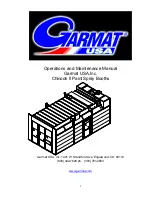
User Manual / CONVERTISS FOLDING PREMIUM
Made by NAUSICAA Medical S.A.S. / Approved by Ghizlane Labrosse (Biomedical Engineer)
15
Checklist for the user
• If you think that there might be damage or a functional problem, the bed must not be used at all and it
must be immediately disconnected from the power supply. It must not be used again until the damaged
components have been totally replaced or repaired!
• To replace or repair damaged parts, please contact the owner of the bed.
6. MAINTENANCE
21
After repeated operations of transport, assembly, disassembly, improper and
long-term use it is not possible to exclude that any damages, faults, wear and
tear problems might occur. These problems may cause safety risks if not
recognised and then rectified before re-use!
Therefore it is necessary both for the owner and the user to follow the safety norms for
medical devices with the implementation of regular inspections to verify the correct
functioning of the bed.
Inform the user that it is mandatory to carry out these check.
6.1 By the user
In addition to regular checks by the specialised staff, even the normal day to day users
(such as nurses, assistants, etc.) must perform both a visual and a functional inspection
before each new use and at regular intervals.
Recommendation: check all mechanical and electrical components once a month. In
addition check the power cord and the hand control cable after each mechanical stress
and after each change of position.
See the checklist below.
Checklist for the user
Control
ok
not
ok
Problem
description
Visual inspection of electrical components
Hand control cable
Possible damages, cable connection
Power cord
Possible damages, cable connection
Hand control
Possible damages
Visual inspection of mechanical components
Lifting pole and its
housings
Possible damages, deformations
Bed frame
Possible damages, deformations
Metal mattress platform
Possible damages, chips
Wooden head and foot
panels
Possible damages, wooden chips
Mattress base
Possible damages, deformations
Metal bed rail bars
Possible damages, chips
Functional control of electrical components
Hand control
Test to check if it works properly
22
Functional control of mechanical components
Casters
Test the brakes, moving forwards
Emergency descent of the
backrest
Test according to the instructions
Bed rails
Locking and unlocking mechanisms
Knee raiser
Mechanism and attachment
Accessories
Fixing, possible damages
Inspector’s signature:
Control result:
Date:
•
If you think that there might be damage or a functional problem, the bed must not
be used at all and it must be immediately disconnected from the power supply. It must
not be used again until the damaged components have been totally replaced or
repaired!
•
To replace or repair damaged parts, please contact the owner of the bed.
6.2 By the owner
The owner of this nursing bed is required to carry out regular tests in case of any new
installation, any maintenance service and during the normal use operations to ensure the
safety of this bed.
These tests must be verified during the regular maintenance services depending on use
conditions.
•
The functional tests, the evaluations, the documentation of the inspection results must be
carried out only by experienced personnel who have the appropriate knowledge and in
conditions necessary to implement the correct testing.
•
The testing evaluation and the documentation of the results must only be performed only
by skilled electricians with additional appropriate medical and technical knowledge.
•
Thetest must be carried out according to the sequence below:
1. Visual inspections
2. Electrical measurements
3. Functional tests
Frequency of the inspections
As a benchmark, we recommend that a full examination is conducted at least every year.
This can be extended to a maximum of two years in accordance with the terms of use on
your own responsibility reflecting a proven fault rate in this time of 2%.
11
The main control box comes already attached to the
knee break actuator with all the cables for the
actuators and the handset connected.
The knee break actuator should be mounted under
the bed frame so that the motor end (the end where
the cables connects to the actuator) is towards the
centre of the bed and the extending ram of the
actuator is connected to the moving knee break
section of the mattress platform.
In order to insert the securing pin into the end of the
extending ram you need to manually lift the knee
break and pull out the ram so that it is away from the
control box it is attached to, allowing you to insert the
locking pin. Please see image to the left.
The backrest actuator should then be mounted under the bed frame again so that the
motor end is towards the centre of the bed and the extending ram is connected to the
moving back rest section of the mattress platform.
Ensure all mounting pins are fully inserted through the bed frame mounting points on both
sides of the actuator and the spring loaded locking loops are in the closed position.
All the cables should be already attached to the control box and numbered 1 – 4 with a
tag on the opposite end where they connect into each actuator. The number inside the
control box (re circles above) should correspond with the same number on the other end
of each cable.
Number 1 cable should be connected into the backrest actuator.
Number 2 cable should be connected into Hi-Lo actuator at the foot end of the bed.
Number 3 cable should be connected into the backrest actuator.
Number 4 cable should be connected into the Hi-Lo actuator at the head end of the bed.
Pay attention to position the back and foot rest actuators correctly! They should
never be inverted.












































